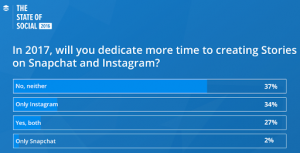What will remain constant in the months and years ahead? It’s a deceptively simple question and the cornerstone of how Jeff Bezos makes strategic decisions.
As the man who sits at the helm of arguably the most successful entities in publishing and eCommerce, he has a perspective worth heeding. With this in mind, here is what we believe will remain exactly the same in three key verticals and how brands in those worlds can capitalize on the inertia.
Prediction #1: Retail
Brick and mortar stores will not greatly innovate or significantly improve the in-store experience anytime soon, amplifying the need for a killer onsite experience.
December was a month to forget for many major retailers, with brick and mortar sales plummeting YOY and holiday shoppers rushing to Amazon before visiting retailers’ websites.
For all the hoopla around Amazon Go, it well may be the only grand brick and mortar concept store to appear this year. Despite beacons, in-store heat tracking systems and a solid uptick in the quality of pop music, the in-store department store experience doesn’t feel markedly different than it did a decade ago.
Retailers will focus on far less flashy endeavors in the months ahead, notably closing the “mobile conversion gap” as well over half of online traffic comes from smartphones but mobile accounts for only 16% of purchases. However, analysts expect mobile eCommerce revenue to hit $ 169 billion by the end of 2017 so there’s good reason for the small screen to get the lion’s share of attention.
Solution: Focus on creating online experiences that are mobile-first but cohesive across platforms. The modern shopper often looks at products several times across devices before ultimately completing the purchase so data must be shareable across size of screen.
Crafting mobile web sessions that immediately bring users back to context of previous visits, inspire serendipity and eliminate checkout barriers are essential now and will be even more paramount in the months ahead.
Prediction #2: Media
Advertising based media will stay with no significant, scalable new business models gaining significant traction.
Last week, Medium announced that it was laying off one-third of its employees, including its entire ad sales team, while declaring that the advertising-based media model is fundamentally broken. This has created another temporary existential soul-searching amongst publishers and a plethora of commentary on alternative revenue streams.
But with online advertising projected to finally overtake television as the primary medium and rake in $ 77 billion in 2017, all of this talk is woefully premature. Ad-based media may well just be the best of a lot of bad options to monetize content but there is still massive room for improvement in the relevancy of advertising.
Additionally, the media industry is still using the wrong metrics in advertising pitches, selling traffic instead of specific audience characteristics to advertisers.
Solution: Embrace highly personalized content that encourages deeper engagement. While media won’t move away from advertising, savvy marketers will finally start paying more attention to the quality of eyeballs and their level of infatuation with content.
Delivering highly engaging reading experiences has always been the name of game, but as advertisers refine their metrics, personalization of content will be even more pivotal.
Prediction #3: Travel
Lack of brand loyalty will endure, particularly among millennials.
Credit cards have replaced frequent flyer programs as the chic loyalty program du jour but haven’t been overly successful in inspiring travelers to stick to one airline. With a vast array of tools at their disposal to price compare, fliers have been more and more frugal, abandoning preferred brands for a little extra pocket change. Hotels have faced similar challenges as a $ 30-a-night couch with only a couple of questionable stains has lured many.
This has caused a much-criticized race to the bottom among several providers ushering an era of discount fares, $ 5 in-flight water bottles and knees getting cozy with tray tables. But while many travelers are indeed demanding this service in their buying habits, applying a strictly price based online experience to all travelers is painfully misinformed and short-sighted.
Solution: Identify travelers who are bargain hunters versus those willing to pay for convenience and present personalized messaging and offers accordingly. Travelers might be cooling on specific brands but many still care about the level of service provided while going from A to B.
In a time when Macy’s is closing 100 stores, the New York Times is telling stories in VR and there is open discussion about self-flying planes, it is easy to plan strategy on the unknown. But for marketers, planting your stakes to the known tedium has long been a winning strategy that seems more and more prudent the weirder it gets.
Business & Finance Articles on Business 2 Community(19)





